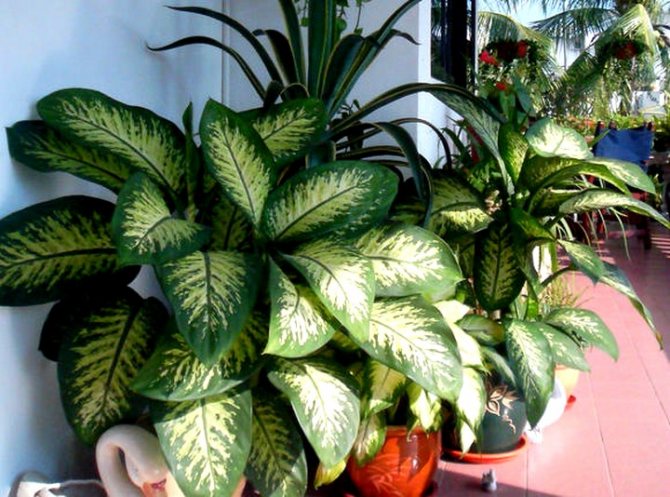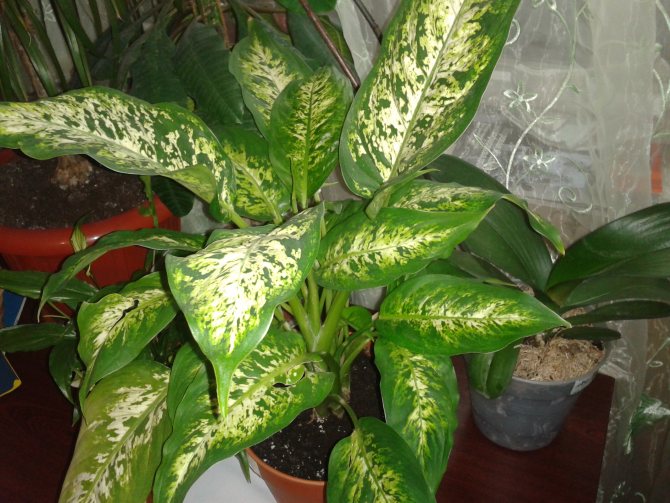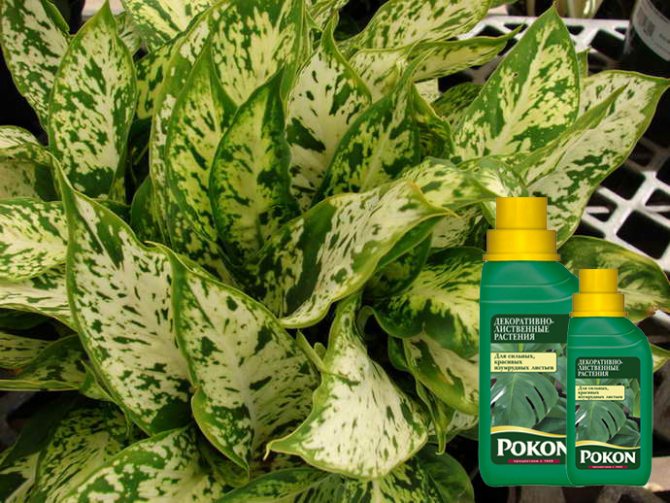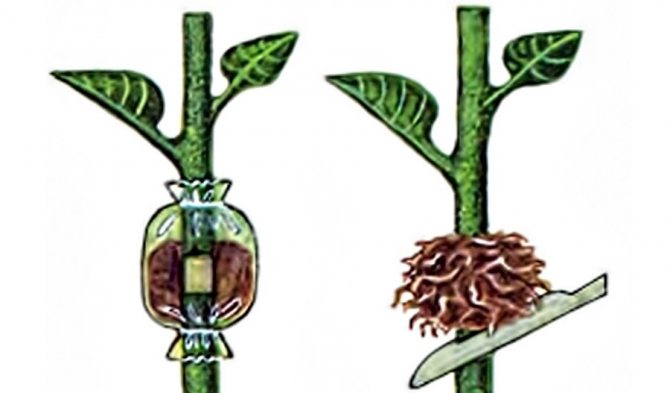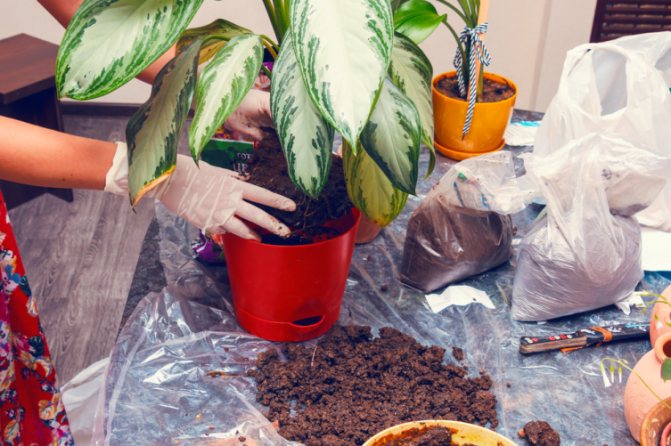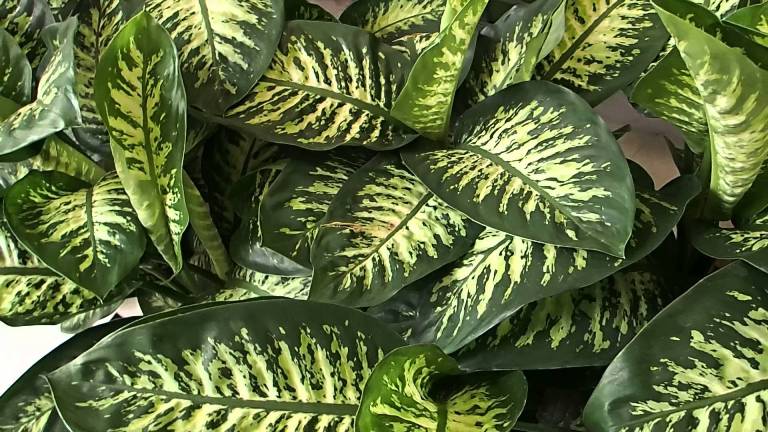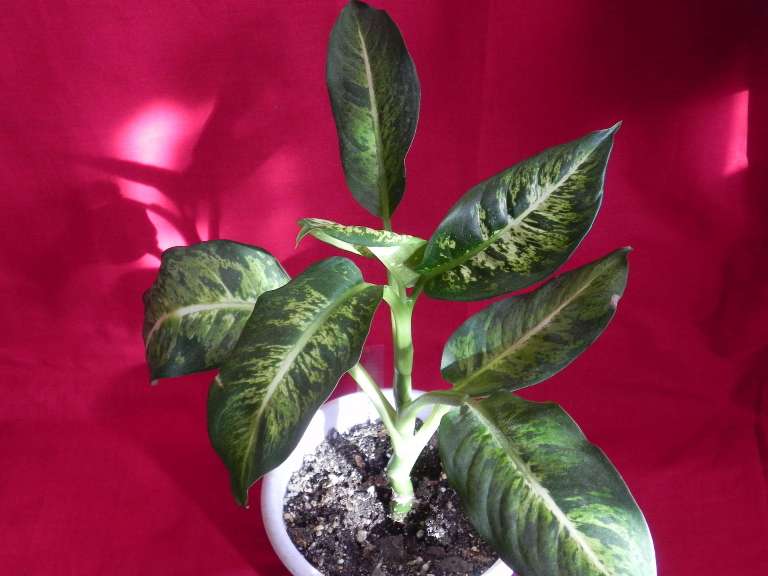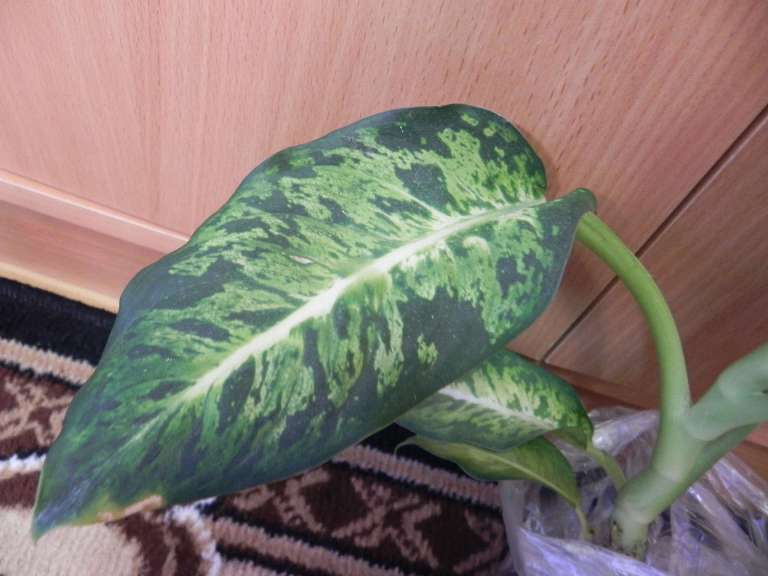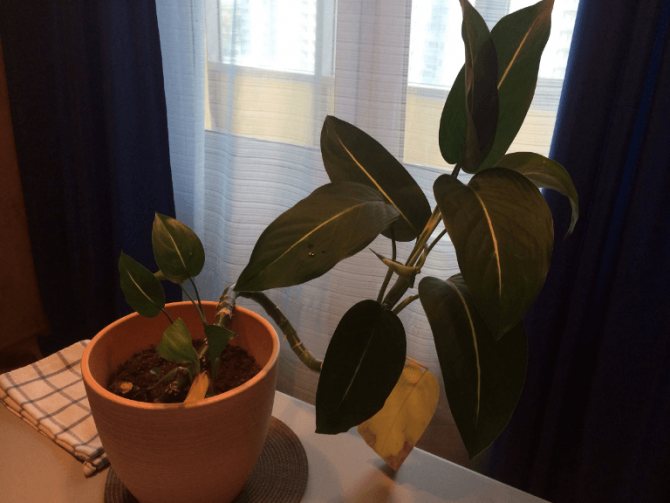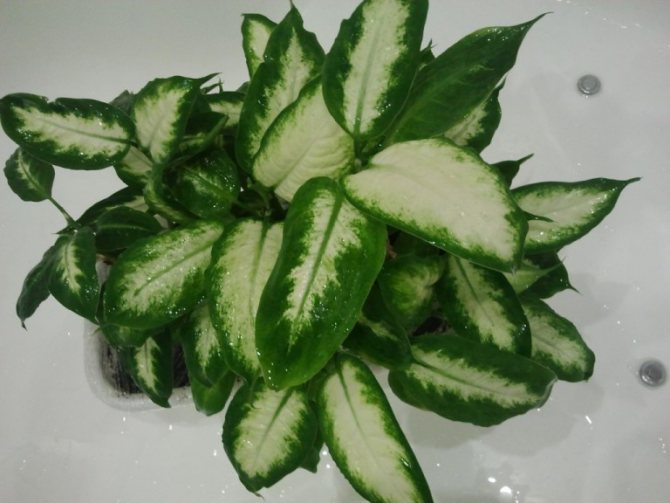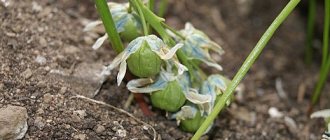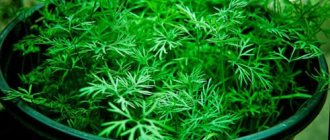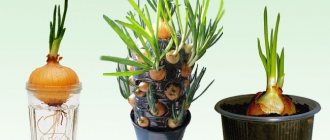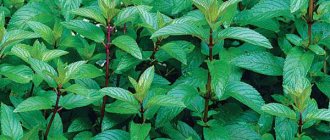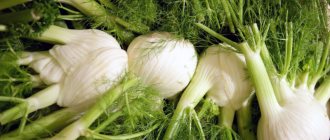Category: Houseplants
Plant dieffenbachia (lat.Dieffenbachia) belongs to the genus of evergreen plants of the Aroid family, growing in the tropical zone of the American continent. The Dieffenbachia flower was named by Heinrich Wilhelm Schott, an Austrian botanist, after Joseph Dieffenbach, the senior gardener of the botanical garden at Schönbrunn Palace in Vienna. In nature, there are about 40 types of dieffenbachia. Indoor dieffenbachia is characterized by rapid growth - some species can reach a height of two or more meters in five years.
Ways to deal with spider mites
If you see that dieffenbachia is covered with cobwebs, this is the first symptom of a spider mite. Tick sizes vary from 0.3 to 0.5 mm, females are purple-red, males are bright red.
Dry warm rooms serve as a favorable environment for its habitat, which is why it is dangerous all year round, being located on the back of the leaf. Dieffenbachia leaves infected with spider mites turn yellow and dry out.
These pests are also insidious in that when unfavorable conditions for their reproduction occur, the female can burrow into the ground and fall into a state of dormancy, before the onset of conditions suitable for life processes.
One female tick lays up to 150 eggs at a time. As soon as you notice that dieffenbachia is in the web, immediately begin to act, since one female can lay 8-10 generations of eggs over the summer.
If the flower is not severely affected, you can wash its shoots and leaves with a solution of soapy water or an aqueous tincture of garlic. In case of intense damage, you need to use insecticides, or colloidal sulfur.
Is it also blooming?
Dieffenbachia is considered a deciduous plant, but nothing beautiful is alien to it. Subject to the correct care conditions, it is quite capable of blooming. Dieffenbachia flower is typical for all representatives of the aroid. It is a long ear surrounded by a greenish or creamy blanket.
Although, blooming dieffenbachia in indoor conditions is a rarity. Most growers who successfully grow Dieffenbachia as deciduous plants have never seen them bloom. It remains only to admire the photo of Dieffenbachia in bloom.
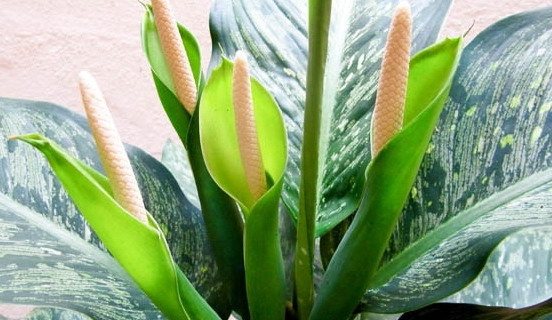
Dieffenbachia bloom is an unusual sight!
Dieffenbachia diseases and their treatment
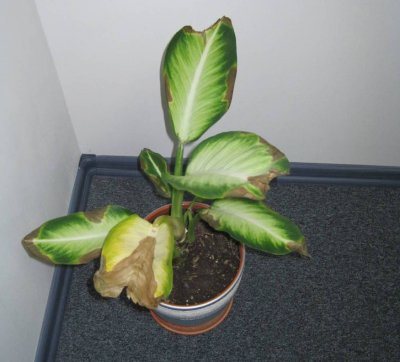

How to help a tropical beauty?
- Dieffenbachia leaves turn yellow, reasons, what to do? Solution to the problem:
- low air humidity. Dieffenbachia, not receiving enough moisture from the air, also begins to turn yellow, so in winter it should be kept away from central heating batteries or buy a humidifier;
- direct sunlight, there should be enough light;
It is necessary to check whether the roots of the flower really began to rot.To do this, you need to remove the plant from the pot, examine the root system, remove the rot and affected areas of the root, transplant the flower into another smaller container, observing the planting rules (drainage 1/3 of the pot, 2/3 soil mixed with sand and peat)
- low air temperature. Dieffenbachia is a tropical inhabitant, she loves warmth, so the temperature in the room should not drop below 22 degrees;
- drafts, which the flower does not like very much, therefore, it is better to keep Dieffenbachia away from the balcony door and vents;
- Dieffenbachia dries up and leaves fall off, leaves tips dry and wither, causes and solutions to the problem:
- fungal infections (atracnosis, leaf spot), fungal spores (leaf spot) can be obtained by the plant with irrigation water, dry brown spots appear along the edges of the leaves, gradually spreading over the entire surface of the leaf, it becomes lethargic, lifeless.
Atracnose is provoked by an excessively high temperature in the room, dry air, in some cases waterlogged soil (excessive watering), in order to get rid of this trouble, it is enough to normalize the temperature and watering regime, the affected leaves can be treated with an ordinary fungicide to prevent infection of other leaves; - the plant grows old, the lower leaves dry, fall off, this is a natural process. It is necessary to rejuvenate it by grafting. To do this, the bare trunk of Dieffenbachia needs to be cut into cuttings, leaving only a small part of the stem in the pot, which will soon give a new shoot and Dieffenbachia will continue to grow;
To combat fusarium, the flower must be transplanted into another pot, after removing rot from the roots and treating the affected areas with a fungicide; - root rot, which appears when the soil is overly fertilized and moist. Rot first affects the root system, then gradually affects the trunk, the flower withers and dies. It is necessary to transplant Dieffenbachia, having previously treated the roots with a fungicide and limit watering;
- waterlogging combined with a low air temperature, in this case it is necessary to provide the plant with a comfortable temperature, to limit watering.
drafts, low air temperature can also lead to drying and falling leaves; to eliminate the Dieffenbachia problem, you need to provide a comfortable indoor climate;
- watering with cold water, it is advisable to defend water for irrigation for at least 24 hours;
- viral lesions (bronze and viral mosaic), usually carried by insects, yellow round spots (bronze) or mosaic of spots (viral mosaic) appear on the leaves of the plant, Dieffenbachia withers, stops in development. It is almost impossible to cope with such a problem, the flower must be destroyed;
- excess watering. The flower protects itself from excess moisture in the soil, a similar phenomenon can be observed before rain, the plant opens channels for moisture to escape, preparing for an excess of water.
In the photo below you will see the symptoms of the disease in Dieffenbachia:
Temperature regime
Dieffenbachia is a thermophilic plant. She needs moderate temperatures throughout the year. It can withstand a short-term drop in temperature up to + 10 ... + 12 ° C, however, after suffering stress, the lower leaves will necessarily turn yellow and fall off.
But dieffenbachia categorically does not accept temperature drops and drafts. In this case, the leaves turn yellow first along the edge, and then begin to dry out. This is a very common phenomenon, which is called necrosis, and is well known to many flower growers.
Pests. Methods of dealing with them
Despite its poisonous nature, Dieffenbachia is susceptible to pest attacks that cause significant harm to it.
Spider mites, aphids, mealybugs, scale insects are most often affected. The method of dealing with each species is the same: it is necessary to wash the leaves and the stem of the flower with a sponge moistened with soapy water (which later needs to be washed off under a stream of warm water) and treatment of Dieffenbachia with an insecticide solution (malofos, 15 drops per 1 liter of water).
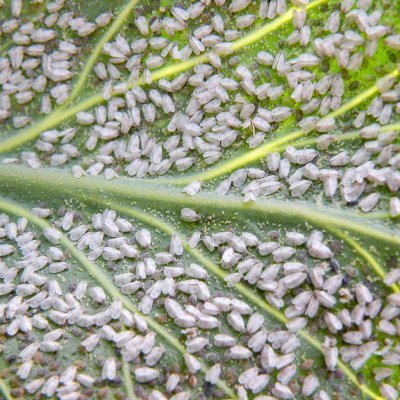

- scale insect - a small insect, with a hard waxy body, usually it can be found on the inside of the leaf, the affected leaves turn pale and fall off;
- the mealybug got its name due to secretions, similar to shreds of fluff, affects the leaves, Dieffenbachia begins to turn yellow and fall off, the flower dies;
- spider mite, the presence of which can be determined by the bloom of cobwebs on the trunk, the leaves of the flower become lethargic and lifeless;
- aphid is an insect that has a dark green color, it can be seen on the inside of the leaves, aphid is dangerous in that it is able to suck out intercellular fluid, weakening the plant and is a carrier of diseases;
- thrips are small beetles that suck the sap from the plant, which leads to curling and drying of the leaves.
Here is all the information about the most common diseases and problems of Dieffenbachia. Of course, it is possible that none of the above may not happen to your plant, but: "forewarned is forearmed", take this article into service and then you can save your pet Dieffenbachia in any situation.
How to deal with aphids on Dieffenbachia
Aphids are especially harmful to flowers. The size of insects reaches two mm, females have no wings, males have. The color of pests can be very diverse: from light green to yellow, red or even pink.
Settling in large colonies on young leaves or sprouts, they suck out the juice from flowers, causing their deformation and transferring viral diseases.
Signs that aphids have attacked Dieffenbachia are the plant's loss of its original color, curling and shedding of leaves, as well as the presence of a sticky layer.
If the flower is severely affected, then it is better to cut off the leaves and shoots. If necessary, repeat the treatment after 7-10 days.
Dieffenbachia diseases: general information
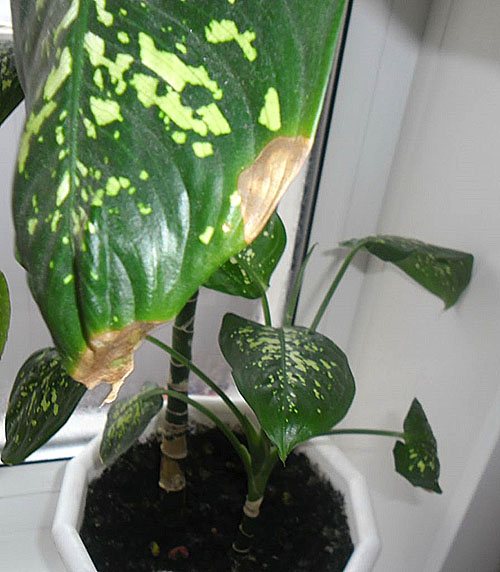

Quite often, lovers of indoor flowers notice how the leaves of a tropical beauty turn yellow. The first thing that comes to mind is the wrong care. But this happens even with the most dedicated flower growers. Dieffenbachia diseases occur for various reasons, the main thing is to start treatment on time.
Another problem of the plant is drying and dropping of the lower leaf plates. Since they are the main decoration of the flower, it is not very pleasant to watch their loss. In some cases, the reason is the natural process of plant development, which even the most competent florist cannot stop. But if young plates fall off, it is worth thinking about the possible dieffenbachia disease and the methods of timely treatment.
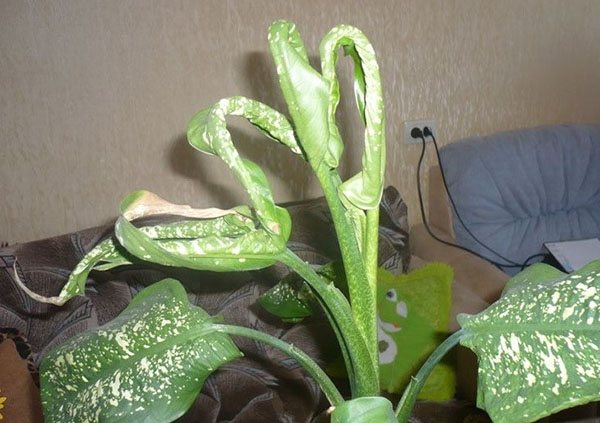

Quite an unpleasant sight when a beloved flower drops the once lush leaves and takes on a miserable look. Dieffenbachia withers for various reasons, but this appearance is a signal for action. In addition, the plant may develop brown spots, droplets of unknown origin, or even non-expanding leaves. Let us consider in detail the possible causes and methods of treating dieffenbachia diseases.
If small children live in the house, an exotic flower can be brought in the office. Such a cute "neighbor" will decorate the room with lush greenery and will always be a reason for joy.
Curling and drying leaves, how to protect dieffenbachia from thrips
Leaves may turn yellow due to too cold temperatures in winter.Also, the leaves turn yellow when the room is ventilated, due to a lack of fertilizers and irrigation with non-softened water, due to root rot disease.
If the lower leaves turn yellow, and the top is actively growing, then the flower needs to be transplanted into a larger pot.
Do not forget that dieffenbachia is poisonous, if its juice gets on the skin, then inflammation occurs on it. Wear gloves when showering or handling the flower. Let your pets and kids not match the flower.
One of the many pests dangerous for diphenbachia are thrips, since temperature fluctuations do not affect their reproduction.
The body of the thrips is narrow with two pairs of wings, 1.5 mm long. The color of thrips is black or brown, the larvae are yellow.
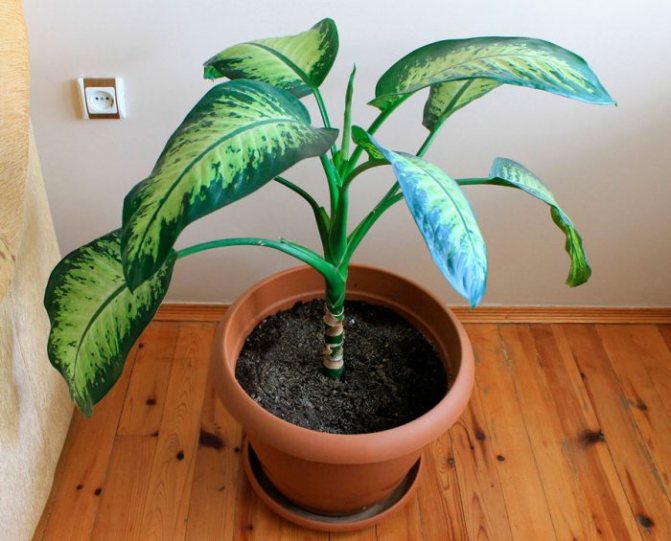

Dieffenbachia affected by thrips is discolored and covered with gray spots. Soon the leaves turn brown and crumble.
These sucking pests (both adults and larvae) cause the main damage to peduncles, which are covered with stains and distorted.
In addition, the plant is covered with a sticky black substance, which can grow sooty fungus. To combat this type of insect, the use of flycatchers and spraying with insecticides will be effective.
Brown spots on leaves: causes and methods of struggle


In one wise book, the simple truth is recorded that all living things suffer from diseases. We see the truth of these words every day. Unfortunately, plants also get sick and the tropical beauty is no exception. Research shows that it is susceptible to fungal, viral and bacterial diseases. One of them manifests itself when brown spots are formed on the leaves of diffebachia, around which there is an orange border. Over time, they spread to the entire leaf, as a result of which it dies.
The main causes of the disease are caused by such factors:
- high room temperature;
- drops in humidity;
- excessive watering of the plant.
If the rules of care are followed and the listed points are not observed, then the plant is affected by a serious disease:
With such problems, brown spots appear on the leaves, framed by a dark line. A fungicide solution, which should be sprayed with an infected plant, will help get rid of the disease.
In order for Dieffenbachia to get enough moisture from the air, it must be "settled" away from direct sunlight, and in the cold season, from central heating.
The best option for growing dieffenbachia is the east side of an apartment or house. Away from the sun, which burns its delicate leaves.
Why are scabbards and false shields on a plant dangerous?
The first symptom of a flower scaly infection is the appearance of yellow dots on the trunk and leaves, which increase in size over time. Then the leaves turn yellow, spin and fall off.
Resettlement of scale insects and false scales occurs by air currents. Attaching to a leaf or stem, they look like scales or growths, as a result of which the plant slows down, its leaves fall off and the flower disappears.
False shields, unlike shields, do not have a dense shell, so insecticides act on them faster.
To eliminate this type of pest, we need:
- brush or soft sponge,
- soapy water solution, garlic water tincture, or insecticide solution.
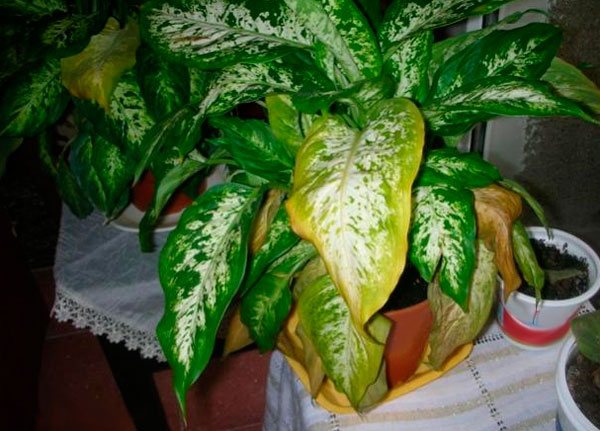

The scabbard and pseudo-scabbard are removed from dieffenbachia by wiping each leaf on both sides, shoots and even the place around the pot, soaked in the preparation with a brush.
Leaf plates do not open: a wise solution to the problem
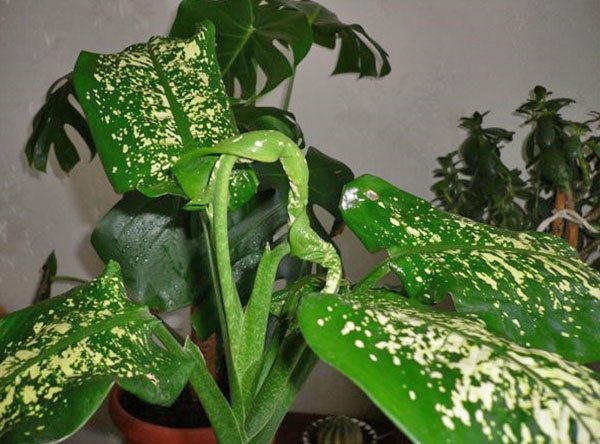

For several decades, Dieffenbachia has gained particular popularity. It can be found in the corridors of clinics and hospitals, offices, educational institutions and even train stations. The main reason is simple care, which consists of such activities:
- regular soil moistening;
- spraying leaf plates;
- growing a plant away from drafts;
- room temperature control;
- the right choice of habitat (away from direct rays of the sun).


Despite this, the plant can get sick. Sometimes it happens that the leaves of dieffenbachia do not open, as a result of which its beauty is lost. Often the reason lies in the following factors:
- direct sunlight falls on it;
- drafts that lead to sudden changes in temperature;
- rotting roots due to excessive moisture;
- low level of humidity in the room;
- lack of useful elements.
Damage to the plant by pests such as spider mites, mealybugs, aphids or scale insects should not be ruled out. If "enemies" are found, the flower should be treated with soapy water. If it does not help, apply insecticides.
Reproduction methods
You can grow dieffenbachia in different ways:
- from seeds;
- from a cutting (stem or apical);
- using an air layer.
Generative reproduction of a flower is used only by breeders whose goal is to obtain new plant species. At home, they often resort to grafting. You can cut and root the top of the Dieffenbachia or split the trunk of an adult flower. Each of them should have a knot in the middle. Stem cuttings are dried for several days and then laid horizontally on a moist substrate made of peat and sand. Their kidneys should be facing up. The container is covered with a film.
For rooting, cuttings need a temperature of at least 25 ° C. When this happens, they need to be transplanted into separate pots. Cutting the dieffenbachia stem into cuttings, leave a stump with at least one knot. Its height should be at least 10 cm. With moderate watering, a new shoot will develop on it. When he releases 2-3 leaves, he is cut and rooted. The number of young shoots that appear on a stump depends on the number of nodes on it.
For rooting apical cuttings, you can use:
- water;
- moss;
- wet sand (in pure form or mixed with peat).
Before placing the cuttings in them, the place of the cut is blotted, removing the poisonous juice that has emerged. Further care includes regular spraying, maintaining the temperature at 21-24 ° C, protection from direct sunlight. Cuttings placed in water are planted when the length of their roots is 2-3 cm.
To obtain air layers, the dieffenbachia stem is incised. The wound is covered with wet moss. From above it is wrapped with an opaque plastic wrap, fixing it above and below the incision. Scotch tape, duct tape or strong thread will help with this. After a while, roots form under it. Then this part of the stem is separated and, carefully removing the film, is planted in a pot. You do not need to remove the moss.
Advice
Bush types of dieffenbachia can be propagated by dividing the bush.
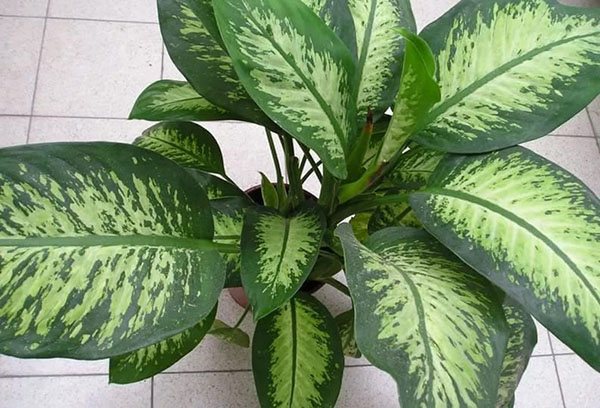

Dieffenbachia "cries" and does not grow
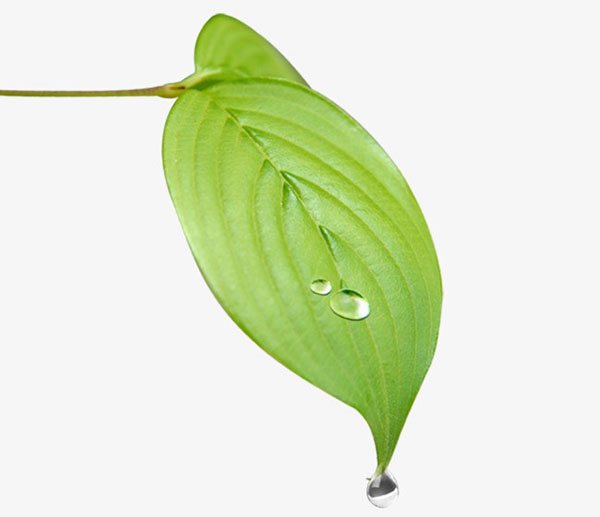

Often, if the plant is not sick, it is distinguished by lush greenery, intense growth and bright color of the plates. But as soon as lethargy appears, the color changes and dieffenbachia does not grow, it's time to sound the alarm. Perhaps the cause was pests or viral diseases carried by insects. As a result, yellow or brown spots form on the leaf blades, which adversely affect the growth of the flower. Coping with a disease can be difficult, so the best way out is to start a new plant, and say goodbye to it.


Sometimes the following factors influence the growth of dieffenbachia:
- lack of light;
- "Drought" on the soil;
- the need for feeding.
An attentive attitude to the flower and simple actions will help to eliminate problems:
- moving to another place in the room;
- regular moistening of the topsoil;
- the use of special fertilizers for dieffenbachia.
Unfortunately, each of us tends to go to extremes.Therefore, excessive watering can lead to root rot and the appearance of a drop on dieffenbachia. It is interesting that in such an extraordinary way, the flower compensates for the excess moisture. Such droplets on the leaves are also found during the period of heavy rains. This is how the plant protects itself from excess fluid.
Another reason for the appearance of wateriness on leaf plates is bacteriosis. Small droplets of moisture may not be alarming at first, but if they are outlined with a visible border, it's time to sound the alarm. Subsequently, the foliage becomes brown and dies. It is better to destroy such a plant in order to prevent the spread of the disease to other indoor flowers.
Transfer
When the roots of Dieffenbachia have grown, filling the pot completely, it will need to be transplanted into a larger container. For young flowers, this procedure may be required 2 times a year. For them, they take a pot, the diameter of which is only 1-2 cm larger than the previous one. In adult plants, the need for a transplant occurs every 3-4 years. It is carried out by the transshipment method.
The flower will take root faster if you transplant it in winter or spring. The optimal dates are February-May. A thick drainage layer is placed on the bottom of the pot. Dieffenbachia is removed from the container along with the soil clod. Having removed the old drainage from it, the flower is placed in a new pot and the voids are filled with a suitable substrate.
Dieffenbachia soil needs loose. It should freely pass air to its roots and dry quickly. You can buy a ready-made potting soil mixture at the store. Baking powder will help to increase its permeability:
- sand;
- vermiculite;
- perlite;
- shredded bark.
Their volume in the substrate should be 30%.
You can prepare soil for dieffenbachia yourself on the basis of four components:
- leafy land;
- peat;
- sphagnum;
- sand.
The components are mixed in a 2: 1: 1: 0.5 ratio.
It is advisable to take care of protecting the plant from decay already at the stage of soil preparation by adding charcoal to it. You can replace it with activated carbon tablet powder.
Advice
Transplanting an adult plant is not easy. In order not to carry out the procedure annually, in the spring the topsoil is renewed in the pot. It is changed to highly nutritious soil containing a lot of compost.


Caution - Dieffenbachia!


Despite its attractiveness, the cute tropical beauty belongs to the poisonous plants. The sap secreted by the plant causes minor damage to the skin. But if it gets on the mucous tissue of the mouth or eyes, a burn occurs. In rare cases, complete intoxication of the body can occur, which manifests itself as follows:
- swelling of the mouth tissues and lips;
- profuse salivation;
- rapid breathing;
- vomiting;
- diarrhea;
- temperature increase;
- tearing.
First aid for dieffenbachy burns, and treatment consists of simple steps. First you need to rinse the affected skin area with running water. For painful sensations, a solution of lidocaine is applied to the burn. If the juice gets on the eyeball, then wash the affected eye with running water for about 20 minutes. Then use drops "Levomycetin" or a solution of furacilin to prevent infection.
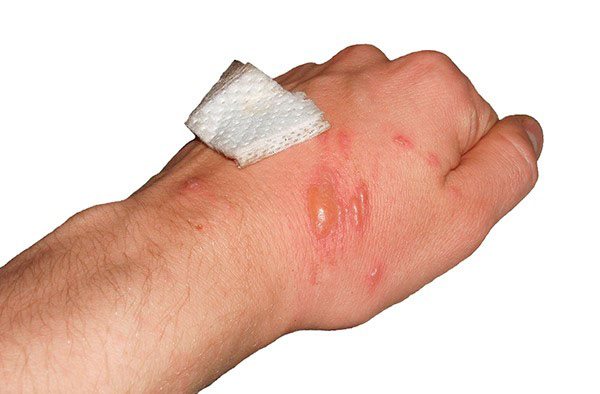

Burns resulting from dieffenbachia juice in the oral cavity are removed thanks to the rinsing procedure. A clearly expressed pain can be quenched with a solution of novocaine (0.5%). After these steps, it is recommended to drink a glass of cold milk or water. In any case, when a problem arises, it is important not to waste time, but to act.
Why dieffenbachia turns yellow - video
> Dieffenbachia - diseases, pests, spots on the leaves. Treatment with photo
When and how to transplant?
Since Dieffenbachia grows very quickly, it is necessary to transplant it every year in the spring. This is done trying to prevent the earth from crumbling from the roots. A new pot is chosen slightly larger in diameter than the previous one.
Step-by-step instruction
- A young plant grows very quickly, because of this, it needs to be replanted annually in the spring. First, make the ground from 2 parts of turf, 1 part of peat, 1 part of humus and 0.5 part of sand.
- The new pot should be 2 cm larger than the previous one. There should be drainage holes at the bottom of the pot.
- Put broken shards, pebbles, expanded clay at the bottom. After that, add a little earth and cross the plant, being careful not to destroy the clod of earth. Then pour abundantly with warm, settled water.
List of common dieffenbachia diseases, their treatment with a photo
How to treat dieffenbachia diseases, the signs of which are often present on the leaves of the plant? Explanations of specialists with detailed photos.
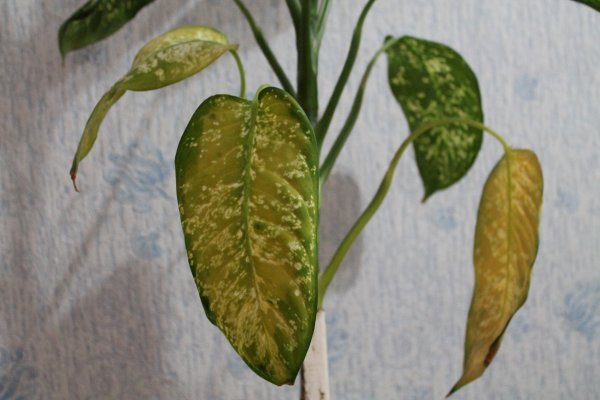

Dieffenbachia leaves turn yellow. It all starts with the lower leaves. Reasons: either this is a natural aging process of the plant, if the conditions for caring for dieffenbachia are fully met, or the irrigation regime is violated. Dieffenbachia leaves turn yellow from excess moisture and sudden temperature fluctuations. The plant needs to be watered abundantly, but not often. Used for irrigation soft, purified water at room temperature. When waterlogged, dieffenbachia leaves will turn yellow intensely, compared to the aging process.
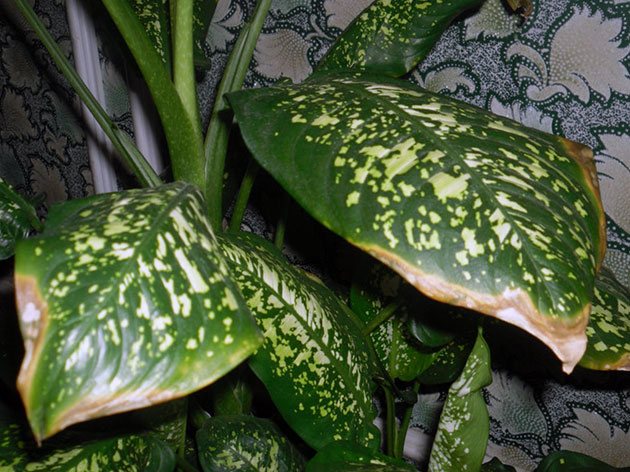

Dieffenbachia leaves dry. Both the tips of the leaves and the entire leaf plate can dry out. Causes of the disease: low air humidity at elevated temperatures. Dieffenbachia is a very sensitive plant, and therefore its leaves can dry out, as a reaction to any factor unfavorable for the flower. The conditions for keeping the plant must be strictly observed.
Dieffenbachia leaves curl. Causes of the disease: unfavorable external factors. Improper care. Leaves can curl from cold air currents (draft from an open window or door) and at low temperatures in the room where it is growing. The leaves of dieffenbachia curl from the disturbance of the salt balance of the soil and from its compaction. It is necessary to transplant the plant by transshipment with partial removal of the earthy clod around the roots. For irrigation use only soft, purified water at room temperature. Conduct the correct feeding. The plant should not be overfed.
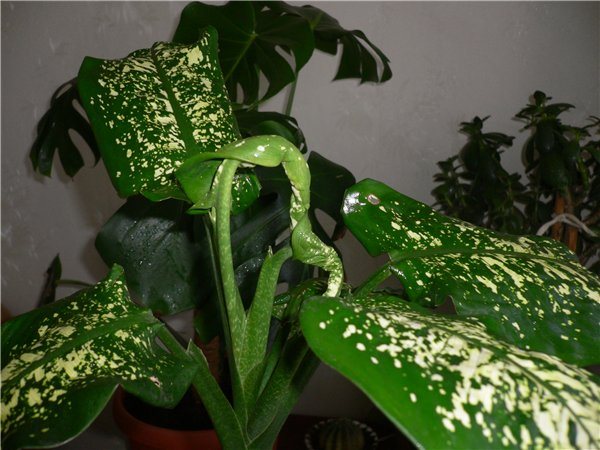

Why don't the leaves of Dieffenbachia untwist or open? Young leaves of dieffenbachia may not open due to lack of sunlight, low air humidity. In this case, the disease is eliminated by normalizing the regime of keeping the flower. In addition, a phosphorus deficiency in the soil can slow down the development of young dieffenbachia leaves and they do not open. Calcium deficiency in the soil is bad for the development of the dieffenbachia root system. As a result, young shoots grow poorly and do not open up. It is necessary to treat the disease with regular complex color dressings, especially during the period of intensive growth (spring and summer).
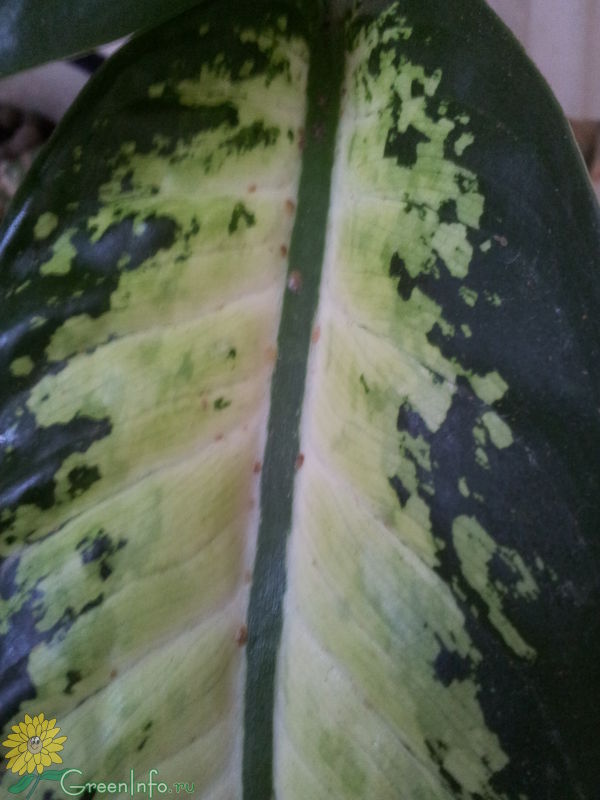

The spots on the leaves of diffendachia are brown in color, similar to plaques, They are easily removed from the leaf. In this case, the integrity of the sheet is not violated. Dieffenbachia leaves turn yellow and fall off. Disease: scale insect. It is a parasite that feeds on plant sap. Treatment of dieffenbachia disease: traditional alcohol treatment can harm the leaf of the plant, and therefore only a low concentration of alcohol can be used. He processes the plant completely with a cotton swab. Insecticide solutions are used: Aktara, Akarin, Agravertin and analogues. Spraying with a solution of 4 g of the drug per 5 liters of water, watering 1 g of the substance per 10 liters of water. Carry out the processing 4 times with an interval of 7-10 days. Dieffenbachia needs to be isolated, you can replace the top layer of the substrate with a new one.
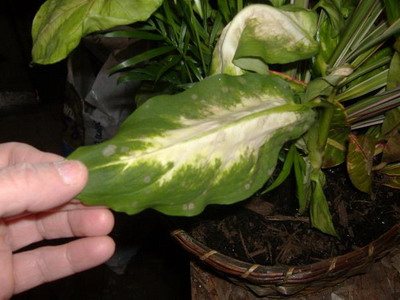

Light brown spots on dieffenbachia leaves that appear on old vegetation gradually spread to the entire leaf plate. Over time, the dieffenbachia leaf dies. Disease: leaf spot caused by fungus.Causes and treatment: the cause may be high humidity and air temperature in the room where the flower grows, excessive watering and lack of light. Dieffenbachia is isolated, the affected leaves are removed, the plant is completely treated with preparations of the fungicide group (foundationol, etc.).
Dieffenbachia leaf is covered with a barely noticeable, white bloom. The leaves gradually lose their decorative effect, turn pale and begin to dry. Dieffenbachia disease: mealybug. It is often present on plants at the stage of larvae - mobile, white insects that have many legs on the sides of the body. Causes of the disease: high temperature and low humidity. Treatment: watering and spraying with Aktara, Fitoverm, Aktarin and intestinal preparations. A prerequisite is the isolation of infected dieffenbachia, the prevention of all plants that were next to it.
Problems caused by improper care
In order for the leaves not to lose their decorative effect, dieffenbachia must be placed in a well-lit place. Let the flower stand on the southern windowsill in spring and winter. At this time, you can still artificially illuminate the flower with fluorescent lamps. But in summer, the flower is shaded a little, since it does not like direct rays of the sun.
It is necessary to constantly water dieffenbachia and spray it daily, or limescale will appear on the leaves. In summer, more water is watered than in winter.
It should be remembered that the hotter it is in the apartment, the more abundant watering is needed.
The plant grows well in summer at 20-22 ° C, and in winter at an air temperature of 15-18 ° C, but if the humidity is increased, then it can grow at 30 ° C. But she does not like stagnant water. Therefore, it is best to often spray it with settled water. You can put a container with moistened sand near the flower.
Flowers do not tolerate drafts and temperature changes. If you want to ventilate the room, then remove the plant from it, otherwise it begins to shed the lower leaves.
Shower the flower every week.
After 10 days, the plant needs to be fed with liquid mineral fertilizers. In winter it is not fed, it rests. Loosen the soil periodically.
As mentioned above, Dieffenbachia grows wild in South America, namely in tropical forests, where it is very warm and humid. In this regard, these plants are very light and heat-loving. And they do not tolerate drafts very well.
Illumination
Feels great on a bright window, but it should be borne in mind that Dieffenbachia does not like direct rays of the sun. If the open balcony is located on the south side, then this plant should not be placed there for the summer.
In the event that it will not get light, its stem will stretch out in the shortest possible time and become very fragile and very thin, and only a few leaves will flaunt at the top.
How to water
When the plant begins to grow actively, it should be watered abundantly. However, in winter, watering needs to be significantly reduced. Waterlogging of the soil should not be allowed. Watering is carried out only after the soil dries out at least a couple of centimeters deep. To check, you can use a special soil moisture meter or check with your finger.
The humidity in the room where this plant is located should be high enough. The fact is that in the homeland of dieffenbachia there is always high humidity. In this regard, the leaves should be sprayed, as often as possible, with plain clean water, and this is especially true in winter, when the air is greatly dried out by heating devices and batteries. A sign that the air humidity is lower than necessary is dry leaf edges.
The room should be at least 17 degrees. It should be remembered that in the autumn-winter period, when it becomes very cold outside, in no case should you open the vents.
In order for the plant to grow and develop well, it must be planted in the correct soil. To do this, you need to make the following earthen mixture: sod land sand peat land leaf land, they are taken in a ratio of 4: 1: 1: 1. Don't forget drainage. It is also quite possible to add brick chips or charcoal to the soil.
When dieffenbachia begins to grow actively, it should be fed quite often, or rather, once every 14 days. Complex fertilization is perfect for this. Also, this plant reacts extremely positively to feeding with nitrogen-containing organic matter.
Reproduction
Most often, the reproduction of this unusually beautiful plant is produced by apical stem cuttings. For rooting, you can use sand, water, or a mixture of 1 part peat with 1 part sand. You will need Kornevin. The lower part of the cutting should be dipped in it before rooting. It is advisable to cover the top with a glass transparent jar or film.
For the cutting, you should choose a place where it is sufficiently light and warm, but at the same time it is worth considering that the direct rays of the sun do not fall on the leaves. The soil should be constantly slightly moistened (not wet). Once every 7 days, when watering, a drug should be placed in the water that promotes early rooting, for example, Zircon, Ekogel, Kornevin, Heteroauxin, Kornerost.
In the event that the cutting takes root in water, and its roots already reach at least 3 centimeters in length, feel free to plant the plant in the soil. If sand is used instead of water, then the cuttings should be fed with mineral fertilizer, or rather, with a weak solution from it (a quarter of the prescribed dose will be enough). The transplant should be done only after the roots have grown very well. It is necessary to transplant carefully together with a lump of the substrate so as not to violate the integrity of the root system.
Dieffenbachia also reproduces well enough in pieces of the stem. To do this, it should be cut into cuttings, the length of which will be approximately equal to 10–20 centimeters, and they should have 3-4 internodes. Dry them for 24–48 hours before planting. Do not forget to sprinkle the slices with charcoal or sulfur. Then they must be placed in the substrate (they should be in a horizontal position) and slightly pressed into the ground so that it covers the cuttings by ½ part.
You should not count on a quick result. The formation of roots, and even more so of shoots, is extremely slow, and this can take from several weeks to 6 months. In the case when the shoots do not appear for a very long time, but the cutting itself does not rot, it should be watered moderately further. The fact is that the rooting process has already begun.
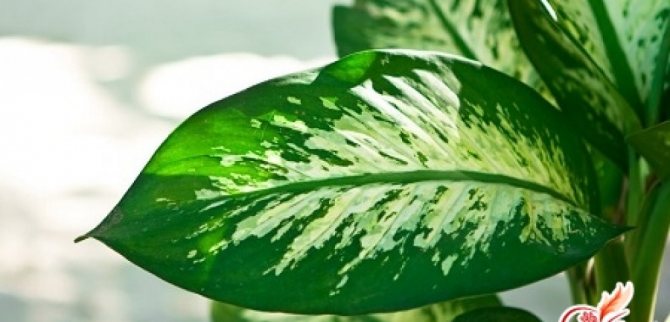

After a while, you will see that a bud has appeared near the soil. And a leaf will already begin to grow from it, and at this time it is important to pour quite a bit of soil to the base of the shoot. After the plant becomes much stronger, a transplant should be made. However, do not forget that at the same time it is impossible to remove the old trunk, otherwise the plant will rot.
You can also propagate the plant using seeds. But to get them, you will need to manually pollinate the flowers. On the cob of the plant are both male flowers (at the top) and female (at the very bottom). The flowers are female all the time covered with the lower part of the bedspread. You will need to carefully cut the coverlet (the incision should be longitudinal), take the pollen from the same inflorescence with a brush and carefully introduce it into the flower. Then use regular tape to seal the incision.
Flowering continues for several days. Then the flower fades, but does not fall off for a very long time. If you did everything correctly, and the flower was pollinated, then orange or red berries should form in its place, but you just need to remember that they are poisonous. The fruit will ripen in about six months.This can be understood when his shell wrinkles. After pulling out the seeds, they should be sown immediately, and chopped sphagnum moss is best used as a substrate.
The transplant is carried out in the spring months and only if necessary. A mixture of sand, peat, leafy earth and humus is prepared in advance. Or you can take a universal soil for fruit-deciduous plants. Take a larger pot than the previous one, and deepen the stem during transplantation. This will encourage the growth of new roots.
Carefully remove the earthen lump from the old pot. Examine the roots carefully. If they are completely healthy, then they can be placed in a pot along with the old soil. Don't forget the drainage layer. To do this, pour a little expanded clay on the bottom. Then it will be necessary to add a small amount of fresh soil, and add it to the sides of the plant, slightly compacting.
In the event that there are rotten roots, then they should be carefully removed during transplantation, having previously shaken off the soil. Sprinkle the slices with activated carbon powder. You can wait until they dry. The plant can then be planted in a new pot.
Pests
On dieffenbachia, a spider mite may appear (there is a cobweb on the stems and leaves), a false shield or a scale insect (the appearance of brown plaques with sticky secretions), and also a mealy mite (a white cotton-like fluff appears).
Dilute actellic, taking 1-2 grams of the product per liter of water, and treat the plant with it. Soapy solution and warm washing will also work.
Diseases
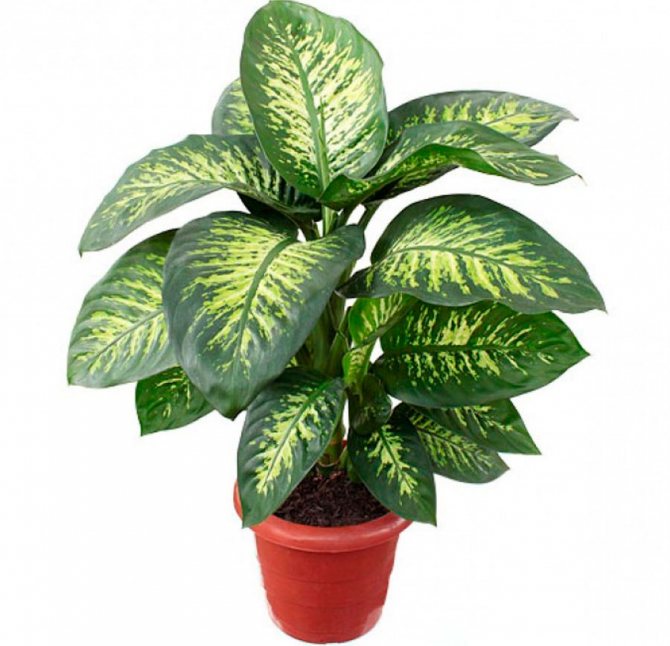

A disease such as rot is very common among dieffenbachia. And it arises due to abundant watering. In the event that the plant begins to wither, leaves fall off, and the soil does not dry out even with rare watering - this is a reason to check the root system for rot. Remove soil and then rot from damaged roots. Sprinkle the slices with activated carbon powder (cinnamon or potassium manganese).
Spill the new soil with a small amount of a weak solution of potassium permanganate. Reduce the amount of watering, and they should be done only after the topsoil dries out by a couple of centimeters.
When breeding dieffenbachia, the following problems and questions may arise:
- Why does dieffenbachia turn yellow, and what should be done in this case? Dieffenbachia leaves turn yellow most often when kept at low air temperatures in winter, in the presence of drafts, insufficient feeding, and if hard water is used for irrigation. If the lower leaves turn yellow, and the top is actively growing, then the plant needs to be transplanted into a container with a larger volume. The tips of dieffenbachia leaves turn yellow and dry when infected with root rot, due to temperature changes, dry air and strong waterlogging of the soil. If the leaves turn yellow and cobwebs form on their lower surface, then this indicates the presence of a spider mite on the plant;
- Now let's figure out why dieffenbachia leaves dry. If the old leaves of a plant dry up, then this is a natural process of their life. In this case, you need to cut off and root the top. If dieffenbachia dries along with new leaves, this may indicate a low air temperature, the presence of drafts and insufficient watering.
- Dieffenbachia withers. This may indicate an overabundance of light and direct sunlight hitting the plant, shading needs to be done. This also happens if the pot has become too small, you need to transplant into a large container;
- White spots on the leaves with a cottony bloom. This indicates that the plant is infected with a mealybug. It is necessary to wash the dieffenbachia with soapy water and spray with an insecticide;
- If new leaves curl or do not unfold in dieffenbachia, this may indicate that watering is carried out using too cold water, the room temperature is low and there are drafts. In some cases, this indicates the defeat of the plant by pests;
- The stem and foliage soften and rot. This indicates an overflow of soil, as well as a low temperature of the content. The affected areas must be removed by processing the sections using activated carbon or sulfur. Next, you need to provide the plant with appropriate conditions. If the lesion is too strong, you can try to cut off the top and root it;
- The brown color of dieffenbachia leaf tips is caused by insufficient watering and low air temperatures;
- Leaves are discolored. This happens when direct rays of the sun hit dieffenbachia, or, conversely, indicates a lack of light. It may also indicate an overabundance of nitrogen fertilizers in the soil and a lack of phosphorus and potash;
- The leaves become small. This indicates a lack of lighting.
Why do dieffenbachia leaves curl?
Dieffenbachia is a green plant that has a powerful trunk and large leaves. The color of the leaves can be different, but it depends on the species, plant variety. There are more than forty plant species native to the tropical region of America.
Dieffenbachia is a plant that can grow up to two meters in height. It is very popular. You can meet him in offices, hospitals and, of course, at home. The plant is easy to care for, so many growers love it. Despite this, the plant requires constant watering, spraying, does not tolerate dieffenbachia drafts, direct sunlight, sudden temperature changes. You also need to take into account the fact that the plant is poisonous, so it must be kept as far away from small children as possible. The sap of the plant can irritate the skin, and if it comes into contact with the oral mucosa, dumbness may appear.
Despite this, the plant is still grown by many. Dieffenbachia, like almost all plants, are susceptible to various fungal and viral diseases. Therefore, let's talk about a question that worries many - why do dieffenbachia leaves curl? There are many reasons, so we'll figure it out.
- The first reason may lie in the defeat of the plant by pests.
- Leaves can curl and turn yellow, lose color due to direct sunlight, especially in hot summer, as well as due to drafts.
- Excessive watering, which can lead to root rot. It is necessary to take into account the fact that you need to water the plant with water at room temperature. To prevent the roots from starting to rot, check the drainage holes, if they are clogged, then clean them.
- Decreased air humidity. Spray the leaves of the plant with water every day. If the air is very humid, then use a sponge to apply a soapy solution to the leaves, which should be washed off after a day. This will help retain moisture.
- From a lack of nutrients, so be sure to feed the plant. Use mineral fertilizers and slurry. Dieffenbachia is fed twice a month in summer, much less often in winter.
- The air temperature in the room where the plant is located must be at least 18 ° C.
Dieffenbachia is a spectacular bushy perennial plant of the Araceae family with beautiful variegated foliage. The popular name of the plant is a light. Dieffenbachia can grow up to 2 meters in height, but the lower part of the trunk is gradually bare, as a result of which the plant loses its attractiveness. Despite some whimsicality, it is often used for landscaping interiors (has been cultivated for 150 years). Read about the features of growing this indoor plant in the article.
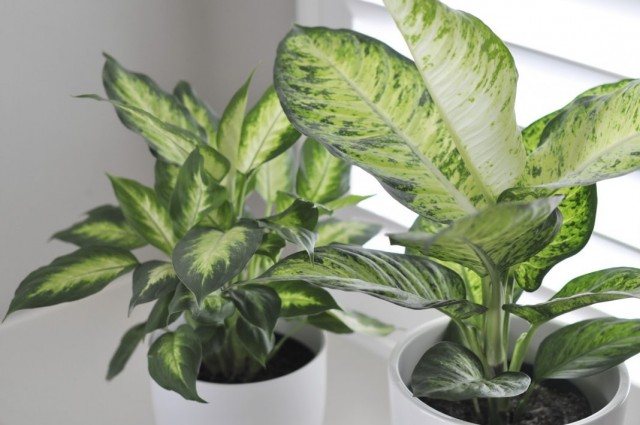

Variegated dieffenbachia in pots
Dieffenbachia harm: myth or reality?
Dieffenbachia is a very spectacular plant, but many growers refuse to start it at home. This is because there is a widespread opinion about the allegedly terrible poisonousness of dieffenbachia. But it’s not that bad. Dieffenbachia juice really irritates the skin and mucous membranes. How does it manifest? Skin that has been exposed to dieffenbachia juice (for example, when dividing cuttings) will turn red and itch. It is enough to wash off this juice with plain water and everything will pass. Allergy sufferers may feel worse and the redness will be more significant. And that's it! Nothing fatal. Afraid of itching? Wear gloves for any manipulation with dieffenbachia, its juice does not corrode rubber.
Parents of young children or pet owners are thinking more seriously about whether it is possible to keep dieffenbachia at home. What to say? Many cats happily nibble on the lower leaves of Dieffenbachia. And they live happily ever after. Although, of course, it is better not to risk it, and if you notice a chewed leaf, follow the well-being of your pet. And if anything, take it to the vet! Although, with a greater degree of probability, dieffenbachia will not bring any harm to the animal. Rather, on the contrary, the plant runs the risk of losing its decorative effect due to the taste preferences of your cat.
As for children, it is certainly not worth conducting experiments. Place dieffenbachia out of the reach of a small child. When he grows up, explain that this plant is poisonous and you cannot tear its leaves, and even more so, pull them into your mouth. There may be a burn to the mucous membrane, which is especially dangerous for allergy sufferers.
Thus, the harm of dieffenbachia is a relative value. But the benefits are obvious. This large meter has amazing properties of absorbing various air pollutants such as toluene, xylene, formaldehyde, benzene (similar cleaning properties ficus benjamin). This means that the air in the room where dieffenbachia grows will be free of these chemicals. But that's not all. Dieffenbachia, which has large leaves, is capable of releasing large amounts of oxygen and ionizing the air. And the last - again, large dieffenbachia leaves evaporate a large amount of water from their surface, respectively, increase the humidity in the room.
Growing conditions dieffenbachia - briefly about everything
Dieffenbachia has a thick, succulent stem, more like a tree trunk, which bears a cap of large variegated leaves. The growth point is at the top of the shoot, but some species are able to bush. At the same time, dormant buds awaken at the base of the dieffenbachia shoot, and sometimes located higher.
The plant requires the following growing conditions:
Lighting. Shading in summer, good lighting in winter. In a too dark place, the leaves become smaller, and the plant loses its decorative appeal. Dieffenbachia will grow well under the protection of a tulle curtain near an east or west window.
Watering dieffenbachia. Abundant from spring to autumn, moderate in winter. The soil is kept slightly moist at all times, but should not be too moist. When watering with too hard water, the tips of the leaves turn brown.
Reproduction of dieffenbachia. Trunk cuttings of 5-7 cm, which are rooted with soil heating at 30 ° C. Some forms produce daughter shoots, which are cut and rooted. To rejuvenate the plant, the top with part of the trunk is cut off, it takes root well.
Air humidity. Dieffenbachia loves very humid air; regular spraying and washing of the leaves is required. Before spraying, make sure that the room is warm and does not "blow" from anywhere, otherwise you can harm the plant. If the room is about 18 ° C, it is better not to spray, but just periodically wipe it with a damp sponge.
Dieffenbachia transplant. Annually in spring - better at the end of April. The soil is a mixture of turf (4 parts), leaf (1 part), peat (1 part) and sand (1 part).Dieffenbachia are fast-growing plants, but due to the fact that the plants grow quite large, transplanting is difficult, in this case it is advisable to replace the top layer of the earth with very nutritious soil. It would be nice to add a little charcoal to the soil.
Dieffenbachia feeding. In the period from May to August, top dressing with complex fertilizer every two weeks. They do not feed in autumn and winter. With a lack of nutrients, the trunk from below is exposed much faster.
Undercutting. It does not need, when pulling the plant, the top can be pinned.
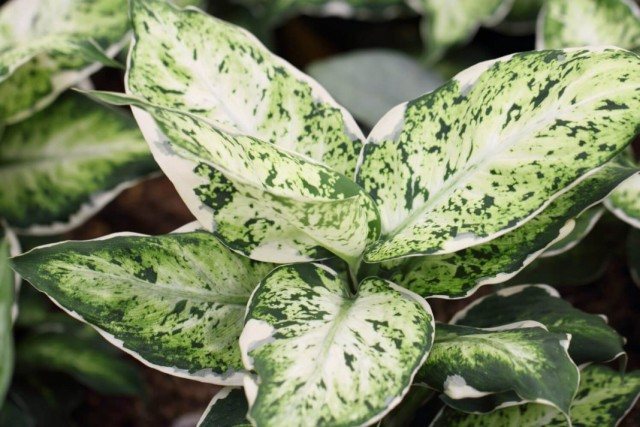

Variegated dieffenbachia (Dieffenbachia). <>
Varieties
Dieffenbachia - this is how the name of an evergreen flower sounds in Latin. He comes from the American tropics. And his name immortalized the memory of the senior gardener Josef Dieffenbach, whose patrimony was the palace botanical garden in Vienna. Nature has created about 40 varieties of plants, but her business was continued by breeders, who have significantly expanded this list.
Favorite florists - spotted and variegated (painted) dieffenbachia. They are distinguished by large leaves, the length of which reaches 50 cm and the width is up to 12 cm. Veins are clearly visible on them, and their bright green surface is covered with bizarre patterns of light spots and lines. The height of the variegated dieffenbachia at home reaches 2 m, and the spotted one does not stretch more than 1 m. Its leaves are slightly larger and have an interesting shape, sharpening at the top.
In breeding work, a spotted plant variety was used more often. She became the ancestor of popular varieties and hybrids: Camilla, Compact, Vesuvio.
The following types of dieffenbachia are also grown in a pot culture:
- Leopold;
- Seguin;
- Oersted;
- Bauman;
- Bause;
- Adorable;
- Magnificent;
- Large-leaved.
These species are distinguished from each other by the height, shape and color of leaves, resistance to adverse factors. Some of them are tree-like. They almost do not form shoots, having one powerful central trunk. Bushy plant species are no less spectacular.
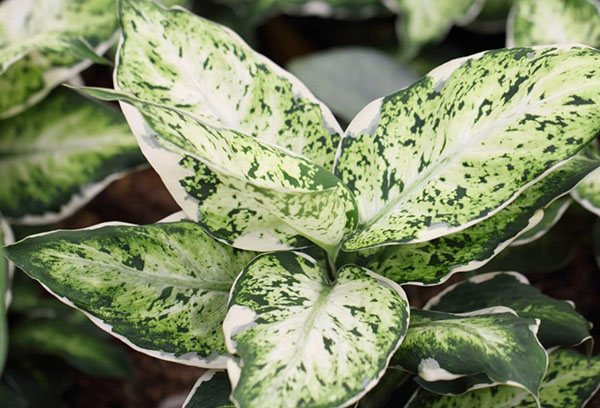

Dieffenbachia care at home
Dieffenbachia, caring for which at home presents some difficulties, is still not as capricious as it is commonly believed. Dieffenbachia flower does not tolerate sudden temperature fluctuations. The most acceptable ambient temperature is + 20..25 ° С. In winter, not lower than + 17 ° С. The best air humidity is 70-80%, so the leaves should be sprayed frequently and washed once every two weeks.
This plant loves fresh air, but does not tolerate drafts. In summer, she feels good on the balcony, if you can find a shady corner there for her, and the rooms where Dieffenbachia lives should be regularly ventilated.
Dieffenbachia spotted loves light, but does not tolerate open sunlight, so in winter it must be kept in bright light, and in partial shade in summer. There are varieties of Dieffenbachia that are quite shade-tolerant, which allows them to be used in dimly lit interiors.
The soil in a dieffenbachia pot should always be moist, but not too wet. Waterlogging of the soil is especially dangerous at low temperatures. This can cause rotting of the roots and stems of the plant. Warm settled water is suitable for irrigation. During the growth period, from spring to autumn, dieffenbachia should be occasionally fed with fertilizers, and in winter, watering and feeding should be reduced, but the earthen coma in the pot should not dry out.
In rooms, some dieffenbachia can grow up to 2 meters, and when watering is insufficient, the lower leaves fall off and the plant becomes like a palm tree. In an old plant, the lower leaves die off and dry up, which is natural, and there is nothing to worry about. If the appearance of a bare-stemmed plant does not suit you, cut the stem to a height of 10 centimeters from the root, dieffenbachia will give young shoots, and the top can be rooted.
Dieffenbachia, the transplant of which became necessary due to the suspension of growth or due to a disease of the plant, is transplanted into a new pot with an earthen mixture consisting of turf, peat soil and sand in a ratio of 2: 4: 1. At the same time, damaged areas are removed and treated with charcoal. Planned dieffenbachia is transplanted annually in the spring. At the same time, the size of the pot is increased, and they do not forget to put drainage from broken bricks, etc. on the bottom of the pot.
Dieffenbachia spotted, or Dieffenbachia seguine (Dieffenbachia seguine).
The origin of dieffenbachia: a biological portrait
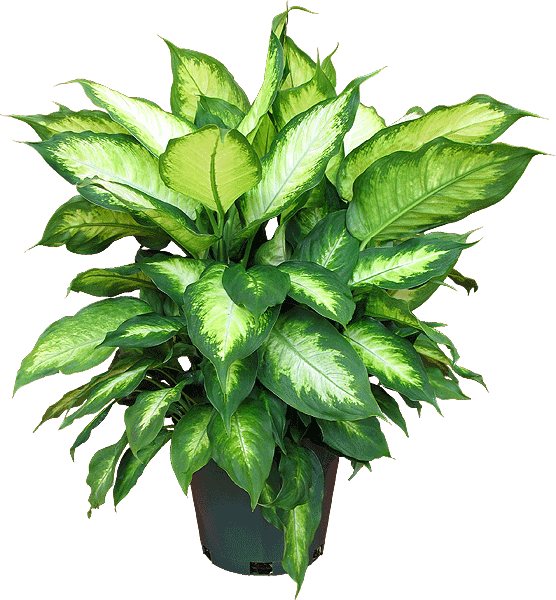

This flower culture is a typical representative of the tropical forests of South America with a large stem and a lush, spreading crown of various shades. It grows exclusively in height, actively stretching out from the base of the shoot. The warm and humid climate is a real paradise for the fastidious beauty. In such conditions, it gains strength and reaches a height of more than 2 meters.
With proper care, dieffenbachia at home develops just as well. As it grows, the stem becomes bare, showing a lush cap of the upper variegated shoots. This shrub of the aroid family is named after a German botanist who took an active part in its cultivation (Dieffenbach). It was he who developed a number of rules for its content.
No matter how gratifying, but the indoor dieffenbachia flower very rarely throws out buds. Under natural conditions, a similar phenomenon occurs more often. Its inflorescences resemble a faded ear, inconspicuous among the lush greenery. At the end of the process, a bunch of red and orange berries appears in their place.
Diseases and pests of dieffenbachia
With unfavorable lighting and a violation of the irrigation regime, dieffenbachia loses its decorative effect and begins to hurt. So, when the soil dries out, cold drafts or at low temperatures, the leaves turn yellow and dry. In too bright light or in direct sunlight, the leaves change color, brown spots may appear on them.
Dieffenbachia, the diseases of which are caused by these reasons, should be moved to a less illuminated, warmer place - where there are no drafts. The plant must be watered on time, and the leaves must be sprayed and washed with warm water.
Despite the fact that dieffenbachia juice is poisonous, this plant is affected by pests - spider mites and scale insects. Occasionally it can be affected by aphids.
The spider mite is a very small red spider. Appears on the underside of dieffenbachia leaves and envelops them with thin white cobwebs. It is destroyed by spraying and washing the leaves, especially from the underside, with water, weak tobacco infusion with green soap, treatment with systemic drugs - acaricides. When washing the leaves with infusions with green soap, after 2-3 hours, the leaves must be washed with warm water.
Read more about the fight against spider mites in the material: Spider mites are an ubiquitous pest.
Shield, or shield aphid, got its name from the waxy shield that covers the body of an adult pest. At first, at a young age, the scale insect is hardly noticeable, but it multiplies rapidly, covering the stems and leaves with dark spots. Adults are motionless and sit under shields, from under which larvae crawl out and creep throughout the plant.
Adult pests, along with shields, are removed with a damp swab, but you still need to treat the entire plant with an insecticide to remove the larvae.
Read more about the fight against scale insects on indoor plants in the material: We save plants from scale insects and false scale insects.
Aphids are small insects that can be green, gray or black in color. It settles on the underside of a dieffenbachia leaf and feeds on plant sap, which leads to drying and folding of the leaves. It multiplies rapidly. Destroyed by insecticides, which are sold in stores or solutions of nicotine sulfate in water with soap in a ratio of 1 g. nicotine sulfate per 1 liter of soapy water.
After processing the plant in a day, dieffenbachia must be washed well, covering the soil with polyethylene. If necessary, the processing is repeated.


Variegated dieffenbachia (Dieffenbachia). <>
Description of the plant
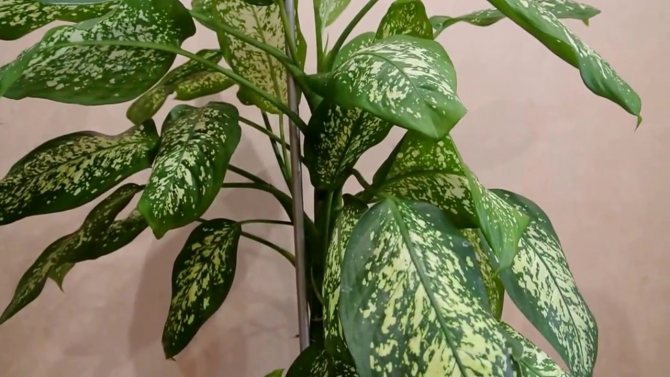

Dieffenbachia is a perennial evergreen of the aroid family, native to the American tropics. Dieffenbachia got its name in honor of the Viennese gardener Josef Dieffenbach, and its discoverer is the Austrian botanist Heinrich Schott. Currently, about 50 plant varieties are known, but not all of them are used for indoor cultivation.
Dieffenbachia juice is poisonous, if ingested, it causes burns of the mucous membranes, swelling of the larynx, and when it comes into contact with the skin of the hands, burning and irritation occur. Given this fact, the plant cannot be started in an apartment with small children and animals, or it must be placed in a place inaccessible to them. Any maintenance work must be carried out with gloves and make sure that the juice does not get into the eyes during pruning.
There are many signs and beliefs associated with such a beautiful, but at the same time poisonous plant. They say that in a house where there is dieffenbachia, boys are not born, men leave the family, lose their masculine strength. The plant is popularly nicknamed "muzhegon". However, not everyone pays attention to signs and superstitions, and live peacefully and happily, having this spectacular plant in the house.
Dieffenbachia has significant positive properties - it is able to absorb harmful chemical compounds, formaldehydes, from the air. Large leaves of the plant release a lot of moisture and oxygen, attract dust to themselves, which improves the composition of the air. This is especially important in winter, when heating devices dry out the air and there is little oxygen in it.
It is noticed that before the rain, water droplets appear at the ends of the leaves of the plant. Dieffenbachia is often placed in the kitchen, as well as in offices and out of the reach of children and animals.
The plant fell in love with flower growers for its very beautiful, large, oval leaves of dark green color with various light blotches, spots, stripes and other patterns, depending on the variety. The leaves grow on a thick, succulent stem.
A flower in dieffenbachia when kept indoors is extremely rare; it looks like an ear, wrapped in a thin cream-colored blanket. Dieffenbachia has a high growth rate, in 5 years the plant can reach two meters in height.
Fertilizer
You need to feed the plant from late April to early October. For this, liquid complex fertilizers for decorative deciduous plants will be the best. Regular feeding - 2-3 times a month.
After the spring transplant, the flower can not be fed for 1-1.5 months. But then you should definitely start fertilizing the soil. Due to the active growth and development of the root system, the potting soil mixture is quickly depleted, the plant needs more nutrients.
Liquid nutritional formulations for indoor flowers must be diluted with water so that their concentration is 2 times less than that indicated on the package. Then the resulting solution is poured over the flower. This is done only 5-6 hours after the main watering of the plant, when the soil in the pot is well saturated with moisture. It is impossible to apply fertilizers to dry soil, as the fertilizer solution can damage the roots of the plant.
Direct sunlight
When direct sunlight hits the leaves of Dieffenbachia, yellow-brown burns are formed, which lead to yellowing and drying of the entire leaf.
It should be remembered that dieffenbachia should not be kept in the sun, but in partial shade..
In the summer, the plant should be placed on the southeast window, where the sun's rays will fall on it only in the morning.
Here, the lighting will be sufficient for good growth, but without direct sun. If this is not possible and dieffenbachia grows on the southern window, in order to avoid burns, it must be shaded.
In winter, the flower requires intense enough lighting.Better to move it to the lightest windowsill. Winter sun rays will not harm the flower; you should not be afraid of the direct sun during the cold season.
Optimal planting time
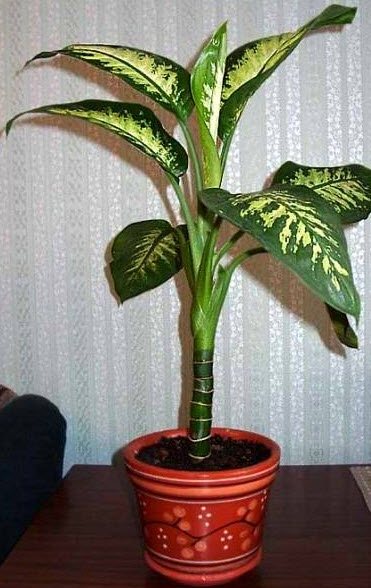

Planting with apical and stem cuttings can be done at any time of the year.
How to choose the right soil (soil composition)
For dieffenbachia, purchased soil with the addition of peat is not recommended. Peat retains moisture, and this can cause the development of fungal diseases that affect not only the roots, but also the leaves of the plant. The soil for it should be slightly acidic with an admixture of leafy earth, sphagnum, crushed charcoal, high-moor peat (you can replace it with coniferous soil) and sand. If the potting soil is still purchased at the store, it is imperative to clarify its composition.
Other causes of yellowing of dieffenbachia leaves
Consider other likely causes of yellow leaves in Dieffenbachia.
Lack of lighting
Dieffenbachia leaves can turn yellow not only with excess, but also with a lack of lighting. If you keep the plant in partial shade, very soon it will begin to shed its leaves. First, the lowest leaf blades will turn yellow and fall off, then the flower will lose most of the green mass.
Read also Grapes pruning running grapes technique
Thus, the reason why the lower leaves turn yellow in Dieffenbachia is a lack of lighting.
Very often, leaf fall begins in winter. Due to the small amount of sun and short daylight hours, the trunk of the plant stretches and becomes bare, the leaves fall off. At this time of the year, it is better to illuminate the plant with special lamps, lengthening the daylight hours.
Lack of nutrition or excess of minerals in the soil
Dieffenbachia reacts very quickly to the amount of nutrients in the soil. When there are not enough of them, she sheds the leaves. This happens in the absence of feeding or in the absence of regular transplants. Therefore, it is necessary to replant even the largest plants, since ordinary soil fertilization is indispensable here.
Sometimes dieffenbachia is fed too often and too intensively... Excessive nutrition can also cause yellowing of the leaves. This plant must be fertilized very carefully, a high concentration of fertilizers will lead to leaf fall and loss of decorative appearance.
Incorrectly selected soil composition
Dieffenbachia is very demanding on the composition of the soil. Most of all, the acidity of the soil affects its appearance. The plant does not tolerate alkaline soils and very quickly responds to the presence of lime in the soil.
With such a soil composition, all leaves of this flower can turn yellow in a short time. To preserve dieffenbachia, an emergency transplant into the soil of a suitable composition will be required.
Pruning
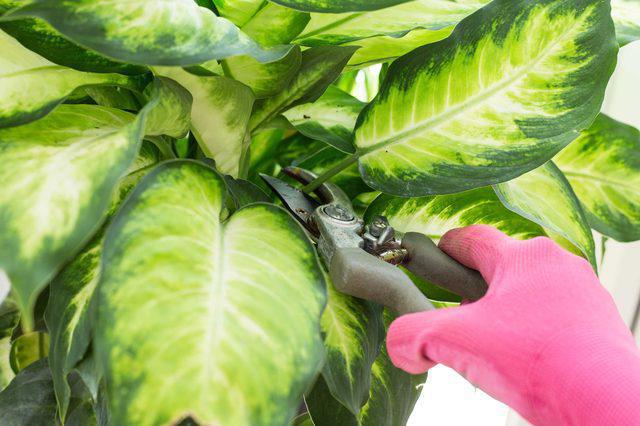

It happens that the owners did not keep track of their Dieffenbachia, and it turned almost into a palm tree, having lost its decorative effect. In this case, radical pruning will be required: the entire upper part is cut off, leaving a stump up to 10 cm high. Young leaves will develop from it rather quickly.
In order to prevent this from happening in the future, the regrown apical stalk, 15-20 cm long, is cut off as it grows back.
Many owners of these plants lament that they have created ideal conditions for them, but there are still no flowers. You can see how dieffenbachia blooms in a photo or in a botanical garden, and not take away the strength from your own plant.
Strong hydration
In case of decay, dieffenbachia, an emergency transplant and a decrease in watering are neededand sometimes it doesn't help either. We have to cut off and root the surviving tops.
To protect the plant from decay, it is necessary to strictly observe its watering regime. You can not fill the flower, but you should not overdry the earthen lump, as this can cause the death of the plant. Keeping the soil moist but not wet is easy enough. Watering is carried out only after the top layer of soil in the pot has dried to a depth of 2-3 cm.
Sometimes plants turn yellow as a result of root rot and with the correct watering regime. This happens when the soil composition is incorrectly selected. Dieffenbachia soil should be light. In heavy soils, water stagnation and root decay are possible.
Useful tips (Note to the flower grower)
In order for dieffenbachia to retain its decorative effect, you need not just take good care of it. Here are some tricks to help growers “improve” plant care.
- If the emerging leaf begins to unfold before it is completely out of the sinus, you can carefully tie it with soft threads. As soon as it is all outside, remove the threads. The sheet will easily and quickly unfold and its edges will not be torn.
- If the leaf is growing faster than it unfolds, there may be a lack of fertilizer. Apply a fertilizer containing potassium, phosphorus and nitrogen.
- Blooming greatly weakens Dieffenbachia. If for you this is not the main factor in its decorative effect, it is better to immediately remove the inflorescence, otherwise the plant will greatly slow down its growth.
- In large pots, dieffenbachia leaves grow larger.
- In the same pot with dieffenbachia, plants such as tradescantia, collision and small-leaved peperomia get along well and look great.
Lighting
In the wild, the plant lives in tropical forests under the crowns of tall trees. therefore direct sun for dieffenbachia is destructive... If the flower is exposed to the sun, its delicate leaves get severe burns. The optimal lighting for him is a light partial shade.
Dieffenbachia grows well in bright, but diffused lighting. It should not be placed in the shade. Lack of lighting will cause excessive stretching of the shoots, their strong weakening. A flower with a lack of light quickly loses its decorative effect.
In winter, dieffenbachia most often suffers from insufficient lighting. It should be moved to the lightest southern windowsill. You should not be afraid of the direct sun in winter, during this period it will not harm the flower.
When is it time to rejuvenate the flower?
Since Dieffenbachia grows quickly and at the same time its lower leaves fall off, reaching the maximum height, the plant loses its attractive appearance. The trunk is stretched out, exposed and may even begin to wobble. As soon as this happens, it is necessary to rejuvenate the plants.
To do this is quite simple: you need to cut off the top and put it in an ode. When roots are formed on the handle, plant it in the ground. In the same way, you can propagate a flower with the help of pieces of the stem.
Dieffenbachia care rules - video
Beautiful and dangerous. It does not bloom often, but this fact does not upset this fact in the least. Many people fell in love with the thermophilic plant with its huge juicy leaves with an unusual color.
An imposing flower is no longer a rarity in offices and residential buildings. What kind of care Dieffenbachia needs, let's try to figure it out.
Tightness
In very small pots, the plant becomes so crowded that it can no longer fully develop. At the same time, its growth slows down, it does not give new shoots, its leaves begin to turn yellow, starting from the bottom. Regular transplanting into new soil helps to preserve the decorative appearance of Dieffenbachia.
The plant has a fairly strong root system, which grows rapidly in the first years of life. Therefore, young plants need to be transplanted annually into new soil and a larger pot. With regular transplanting, the flower retains most of its leaves, losing only the lowest. If you skip the transplant, then this will immediately affect the appearance of the young plant, the leaves of which will begin to turn yellow and die off.
Decrease in temperature and draft
Dieffenbachia is a thermophilic tropical plant. At low temperatures, dieffenbachia can shed all the leaves. (especially with a sharp drop in temperature).
The leaves turn yellow very quickly throughout the plant and fall off, except for the very top ones.
The reaction of dieffenbachia to a draft is drying and yellowing of the tips of the leaves. If such symptoms occur, you need to remove the plant away from the opening windows, otherwise it may turn completely yellow, and then lose all foliage.
Dieffenbachia can also react when kept in an air-conditioned room. Being near the air conditioner under a stream of cold air, it will certainly shed its leaves and lose its beautiful appearance.
The soil
Usually I bought ready-made earthen mixtures for the desired type of plant. But a few years ago I had to urgently plant dieffenbachia in the soil that was at hand at that time. And although this option was considered temporary, it turned out to be the most optimal for the plant. Unlike the previous experience, when the plant grew rather sluggishly, with the new planting option, the shrub pleased not only with larger leaves, but also gave new shoots twice.
So, at the bottom of the five-liter pot were laid pieces of red brick, which remained after the repair. On top of them, I poured expanded clay - drainage for cacti. drainage amounted to almost a third of the pot. The next layer was the remnants of purchased land for cacti (almost sand). The penultimate layer was a light turf soil with a fair share of dry spruce needles. And finally, the last layer was black soil from the garden, diluted by a third with sand.
Planted in the remnants of different soils, the bush surprisingly quickly took root and delighted everyone who contemplated it with its appearance: the leaves became large, juicy, shiny.
Pest infestation
When a spider mite is affected, yellow spots first appear on the leaves of the plant, which then capture the entire leaf plate.
This pest is easy to spot on the underside of the leaves, which may be completely covered in fine cobwebs. Usually, treatment with special chemicals allows you to quickly destroy the pest.
Already yellowed plates are not restored... Over time, they dry out and fall off. But the elimination of errors in the care of the plant will lead to the regrowth of young healthy greenery.
Shrub varieties will become lush and green in color. Old tall plants that have lost their leaves are best updated by cutting and rooting the tops. After that, new plants need to create optimal conditions for growth and development.
Dieffenbachia leaf propagation technology
The beauty of Dieffenbachia is that it is fairly easy to propagate. For this, an already adult plant is better suited, the age of which is more than two years. It is better to cut the leaf from the very top and as close to the trunk as possible.leaving several buds on it. To avoid over-saping, you should reduce watering a few days before pruning. It is better to cut the stalk with a sharp, serrated blade so as not to injure the internal fibers. The cut off top can be placed in water or immediately planted on the finished soil.
Comments (6)
Irina
31.10.2017 at 01:02 |
At one time I had dieffenbachia. I didn't fertilize her with anything. She took the soil from the flower bed. Sometimes I watered it with the remnants of mineral water, without gas, of course. When we bought new furniture, we had to give the palm tree to a friend, there was not enough space for it. Unpretentious plant to care for.Reply
Julia Expert Plodogorod
22.07.2019 at 22:28 |
Hello Irina! Despite the fact that this plant is quite unpretentious, with correct feeding it will look better. The leaves will become larger, more saturated in color.
During the period of active growth, that is, on spring and summer days, you need to feed the described indoor flower twice a month. You can use complex mineral dressings, or already diluted special products for decorative leafy indoor flowers.
For example, Mr. Tsvet and Gilea products are often used for decorative deciduous plants.
This variety accepts foliar fertilizers well.It is only important not to carry out the procedure if the plant is in direct sunlight. It is better to shade the flower for the duration and several days after it. For this, plain thin paper located on the window pane is suitable.
For the foliar feeding procedure, we recommend trying the Doctor Foley starter. If you decide to use another remedy, you need to study the breeding rules. For this method of administration, the doses are much lower and less concentrated.
If you are not sure how to dilute the product correctly, it is best to consult your point of sale or flower shop. Otherwise, you can only burn the crown, and not nourish the flower.
From the beginning of autumn to the end of winter, such a plant requires less nutrients, since much less energy is spent on development. Therefore, during this period of time, it is not worth fertilizing dieffenbachia.
Reply
Irina Kalinina
27.12.2017 at 08:10 |
I have been growing Dieffenbachia for many years. There are times when the leaves turn yellow. My lower leaves turn yellow. I think this is a natural process. When it reaches a large size, I cut off the top and plant it. One copy stands on the floor and has already grown to the ceiling. Very nice. If the upper leaves turn yellow, then perhaps a small pot, improper watering. Fertilize the plant, remember to spray.
Reply
Julia Expert Plodogorod
22.07.2019 at 23:10 |
Hello Irina Kalinina! The yellowing of the lower leaves can indeed be caused by natural processes. But in order to avoid the progression of this process, it is better to take some measures.
In addition to improper watering and lack of nutrients in the soil, the reason may be improper lighting. Moreover, the crown can suffer both from a lack of sunlight, if the plant is located on the north window or far from the windowsill, and from direct sunlight in the summer.
Problems with foliage and the general decorative appearance of a flower can be observed due to the appearance of pests. If ants sometimes appear in the house, then you need to regularly inspect indoor plants for aphids. These insects are dangerous not only because they feed on flower juices, they can be carriers of infection.
For treatment, a solution of boric acid is used as a spraying, as well as special preparations such as Actellik and Aktara.
If, in addition to yellowing of the foliage, wilting is also observed, as well as drying and falling of the crown, you need to check the flower for the presence of a small thin cobweb on all vegetative parts. If such symptoms are found, the flower has been struck by a tick.
To reduce the pest population, plants are regularly sprayed with water. In this case, it is better to cover the ground with something to avoid waterlogging. For treatment, you can use the drug Neoron.
You are absolutely right about improper watering. But, if it was systematic and began to affect the crown of the plant, most likely the root system has already suffered. You cannot do without replanting and replacing soil. Also, it is better to remove damaged roots to healthy tissue and water the plant with a solution of manganese or boric acid.
Reply
Irina
15.06.2018 at 11:10 |
Twice she got Dieffenbachia and twice was not successful, then it turns yellow and dies, then the leaf is small, and the trunk is thin and soft. Now I understand what I did wrong. I am sure that the next attempt will be successful.
Reply
Julia Expert Plodogorod
22.07.2019 at 23:40 |
Hello Irina! For starters, if you are using the same pot for planting this plant, it is best to wash it with baking soda and rinse it with boiling water. After all, if earlier the flowers died, the reason could be in the disease.
Further, we recommend that you lay a drainage layer on the bottom. It can be any small pebbles or shells. Directly in the bottom of the container there should be a hole, and preferably several for the outflow of excess moisture.
The soil mixture should be light and well-drained, but nutritious at the same time. In order to achieve such a composition and structure of the soil, it is necessary to add rotted humus and deoxidized peat. When the soil mixture is ready, it is better to pour it over with boiling water or roast it in the oven. This will kill harmful bacteria and insects.
The softness of the trunk may indicate the development of a putrefactive or fungal infection that has affected the rhizome. If the land was disinfected before planting the plant, then the reason is in the disease of a nearby plant, or in an incorrect watering regime.
In the first case, you need to inspect your pets for spots, growths, spores, or some other signs of wilting. If this is found, the flowers should be treated with an appropriate fungicide. If other specimens are healthy, you need to transplant the plant into clean soil, treat the roots with Magnicur Energy and normalize watering.
Perhaps the reason is not only the excess of water. If the moisture is too cold or has a lot of harmful impurities, this may also be the reason.
We would like to note that the described symptoms can be observed not only from a lack, but also from an excess of fertilizers applied. Namely, nitrogen-containing agents. This element in large quantities is capable of provoking a softening of the rhizome, which makes it vulnerable to infections.
The fact that a flower has small leaves indicates a lack of light, or about the same disease of the rhizome. Indeed, such roots cannot fully absorb nutrients, which significantly reduces the strength of the plant for crown formation.
If problems start again with the new plant, try sprinkling it with medicine for the fungus. If it does not help, then transplant. As a last resort, you can take a cutting. We would like to note that it is impossible to feed a diseased plant, this will only worsen its condition.
Reply

